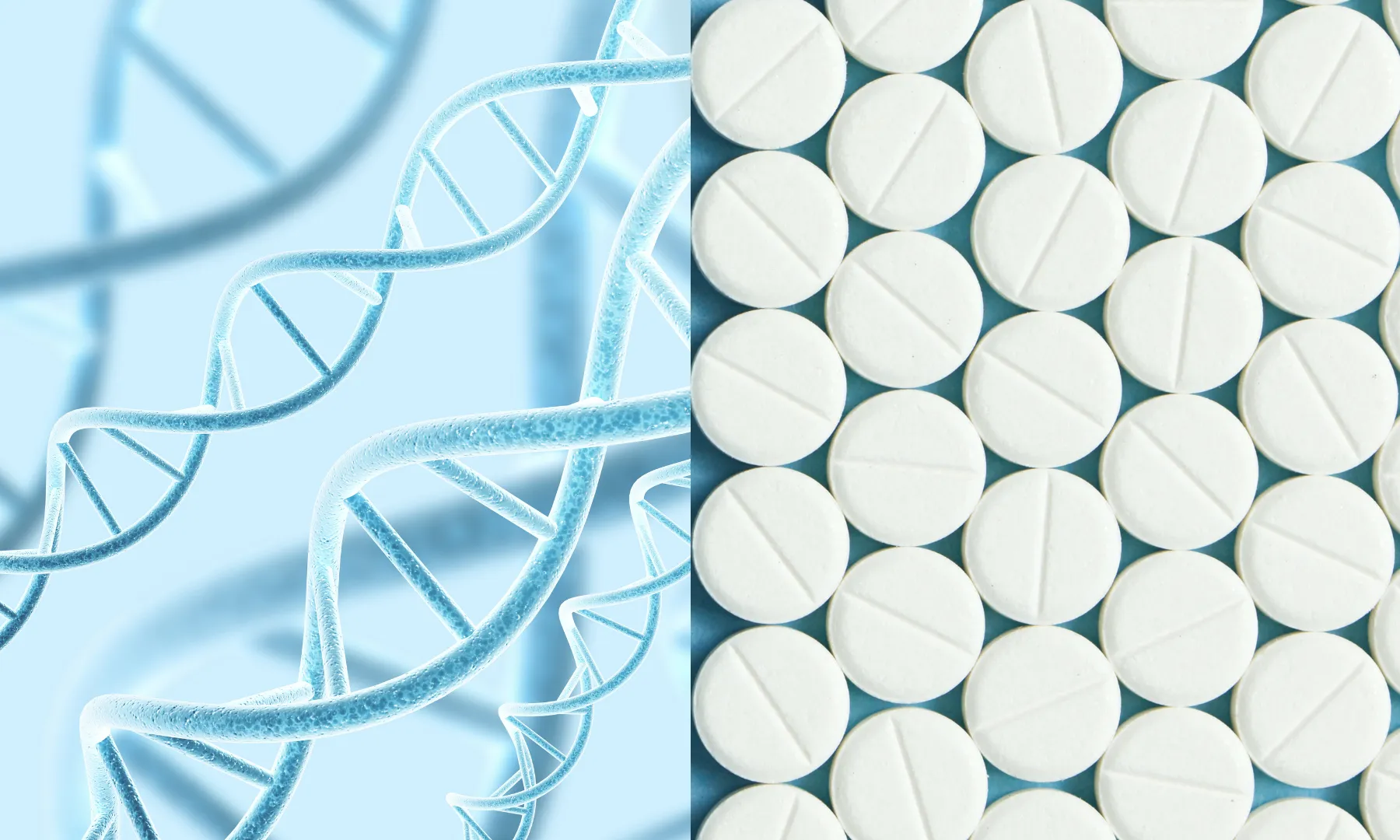
Why does one patient’s warfarin levels crash from a kale smoothie, while another downs late-night espresso without skipping a beat? Simple: it’s their genes. Variant-driven nutrient–drug interactions are no longer guesswork — they’re predictable. And thanks to diet and genetic testing, they’re actionable.
We’ve already mapped how VKORC1 and CYP2C9 control vitamin K’s dance with warfarin. The same goes for CYP1A2 and caffeine, or SLCO1B1 and statins. These aren’t theoretical — they’re daily-use levers.
And when you think you understand the warfarin-vitamin K axis, vitamin C can cause further unexpected changes. Some nutrients don’t behave as expected — which is precisely why you don’t guess. You test. Then you personalize.
Key Takeaways
Nutrigenomics and pharmacogenomics together empower precision medicine to deliver truly personalized supplement and medication plans.
Key gene-nutrient-drug interactions, like VKORC1/CYP2C9 with warfarin and vitamin K, or SLCO1B1 with statins and CoQ10, are essential knowledge for safe protocol design.
Screening patients’ medications and integrating nutrigenomics data into workflow reduces risk and maximizes the effectiveness of nutrition interventions.
Effective patient education and diligent documentation are critical when using pharmacogenomics and nutrigenomics to transform clinical applications.
Staying current with continuing education in nutrigenomics and pharmacogenomics ensures practitioners can provide cutting-edge functional medicine solutions.
Table of Contents
Understanding the Role of Pharmacogenomics in Functional Nutrition
Picture this: You’re creating a supplement plan, but one of your patients is on blood thinners after a minor stroke last year. How do you make sure your recommendations help, not harm?
That’s where pharmacogenomics comes in. In the world of functional nutrition, this field is like a backstage pass; it uncovers how someone’s genes dictate their response to medications and, just as importantly, how those responses overlap with the nutrients you’re prescribing.
The Convergence of Nutrigenomics and Pharmacogenomics
Let’s untangle two terms that often show up together: nutrigenomics and pharmacogenomics. Think of nutrigenomics as the study of how food ingredients, such as folate, choline, or B vitamins, can “talk” to genes and modify their expression. In contrast, pharmacogenomics looks at how genes shape your body’s reaction to drugs and, by extension, how to avoid expensive headaches down the road (we’re talking adverse reactions, not literal migraines, though those happen too).
The sweet spot for functional medicine is where these two overlap: nutrient–drug–gene interactions. Here’s where things get interesting for nutritionists: pharmacogenomics for nutritionists isn’t just a niche; it’s an indispensable toolkit. Personalizing supplement protocols means understanding both sides: which genes impact a’s effect, and how nutrients (or deficiencies) could tip the balance.
Overlapping Metabolic Pathways: Drugs and Nutrients
Let’s get a little nerdy with enzymes. Enzyme pathways, like those in the cytochrome P450 (CYP450) family, act like traffic cops in the liver, directing both nutrients and drugs. For instance, CYP1A2 metabolizes caffeine but also processes medications for anxiety or blood pressure. Throw in a gene variant, and suddenly that cup of joe is interfering with a blood pressure med, or statins are zapping energy due to reduced CoQ10.
Here’s a quick cheat sheet:
Enzyme/Transporter | Affected Nutrient | Affected Drug |
|---|---|---|
CYP1A2 | Caffeine, cruciferous veggies | Caffeine, some antipsychotics |
CYP2C9 | Vitamin K | Warfarin |
VKORC1 | Vitamin K | Warfarin |
SLCO1B1 | CoQ10 | Statins |
CYP3A4 | Grapefruit, vitamin D | Many statins, certain antihypertensives |
Spot the pattern? It’s not just what you eat or the pills you take, it’s how your genes choreograph the metabolic dance.

High-Impact Gene–Drug Case Studies
Nothing lands a point home like seeing the science in action. Here are three real-world examples every practitioner should know:
Warfarin + Vitamin K → VKORC1 / CYP2C9 Variants
If you’ve ever worked with anticoagulant users, this one will ring a bell. Warfarin acts by blocking VKORC1, a gene that manages vitamin K recycling, a key player in blood clotting. But factor in a CYP2C9 variant that slows warfarin metabolism, and suddenly the routine spinach salad becomes a wild card.
A patient might follow a so-called “vitamin K–rich” diet, thinking they’re boosting heart health, but if their genes say otherwise, their INR spikes or plunges. The fix? Order a VKORC1 and CYP2C9 genotype and chat with the prescribing doc before tinkering with supplements. Peer-reviewed data backs up just how much these genotypes swing dosing requirements, by as much as two-fold among individuals.
Statins → SLCO1B1 and CoQ10 Depletion
Ever meet somebody who starts statins but can barely get off the couch after a week? It’s not laziness. The SLCO1B1 transporter gene snatches statins from the bloodstream and shuttles them into the liver. If someone carries the SLCO1B1*5 allele, their risk for muscle pain (myopathy) shoots up. Worse still, statins drain CoQ10, a mitochondrial must-have, so that fatigue isn’t all in their head.
For these folks, genetic testing is a lifesaver. Consider suggesting a different drug or adding a CoQ10 supplement. Personal anecdote: I had a client who cycled through three statins before someone finally ran SLCO1B1 testing. Turns out, it was never a willpower issue, just genetics meddling with metabolism.
Caffeine → CYP1A2 and Cardiovascular Risk
Why does your co-worker pound cold brew and sleep like a baby while you get palpitations from half a green tea? The answer: a single letter in the CYP1A2 gene. Fast metabolizers breeze through caffeine with minimal risk: slow metabolizers hang onto it too long, raising blood pressure and anxiety, especially if they’re taking certain supplements targeting stress or heart health.
If a slow metabolizer loads up on caffeine, their “wellness stack”, like green tea extract or guarana, may backfire, driving up hypertension risk and wrecking supplement synergies. That’s a big reason I always check for CYP1A2 before suggesting any stimulant blends.
Building Safe Supplement Protocols
Solid supplement protocols shouldn’t be a guessing game; no one needs a side of surprises with their morning vitamins.
Screening Medications Before Nutrient Recommendations
Before you pick a single pill or powder, grab their list. Cross-reference everything, Rx, OTC, and even that “benefit natural energy booster”, with gene and nutrient pathways (CYPs, VKORC1, SLCO1B1, and so on). Digital tools like PharmGKB, ClinVar, and even some EHR-integrated alerts can be a lifesaver when you’re juggling a complicated case. I once caught an interaction between an SSRI and St. John’s Wort just by running a few checks, dodged a bullet there.
Integrating Nutrigenomic Reports into Clinical Workflow
You know all those juicy details in a patient’s genetic report? Don’t just file them away. Focus on actionable, functionally validated variants, skip speculative mutations unless the evidence is rock-solid. Map the genotype to enzyme activity, connect that to nutrient dosing, and jot down the rationale (and evidence) in the chart. It’s the difference between data overload and a clear, confident plan.
Documentation and Legal Safety
Everyone’s nervous about legal risks in the wild world of genetic data. Your best friend: detailed, honest, reflective record-keeping. When you test VKORC1, for example, include the gene, why it matters, the specific nutrition tweak you made (“reduced green smoothie frequency, patient educated on vitamin K-warfarin interaction”), and document your discussion about risks and consent. That record could save you a world of headaches if questions arise later.

Patient Education and Consent Language
Explain pharmacogenomics to your patients the way you’d break down TikTok trends to your parents: simple, visual, and free of jargon. “Genes are recipes: nutrients and meds are the ingredients and seasonings, they interact to produce very different dishes in each person.”
Hand out brochures and visual aids, enzyme maps, or color-coded “stoplight” guides (red for risky combos, green for go-ahead foods, yellow for caution). For consent, cover the why (“This info will help us pick the safest, most effective plan just for you”), talk privacy, and encourage teamwork (“I’ll coordinate with your prescriber as needed”).
A favorite one-liner: “Your genes are the blueprint: I help you build the healthiest house possible with what you’ve got. It’s a collaboration.” That lands with anxious patients every single time.
Mini-Case Scenarios for Practice
Case 1: Warfarin User with Green Smoothie Habit
A 70-year-old (we’ll call her Evelyn) loved her daily kale smoothie until her INR swung wildly. Turns out, her VKORC1 and CYP2C9 status made her a warfarin “hyper-responder.” Step one: repeat lab, pause supplements, and explain the interaction using a traffic light analogy, vitamin K (red light) slows warfarin, MTHFR/folate tweaks (yellow light) also affect clotting. Worked with her doc, tightened the diet, and, no drama, Evelyn felt heard instead of lectured.
Case 2: Statin-Intolerant Patient with Muscle Fatigue
One client, “Dave,” looked like a textbook statin dropout. He’d quit two lipid meds with blowout fatigue and muscle aches. Ran an SLCO1B1 panel; he carried the *5 allele, confirming the myopathy risk. Solution: cut the statin, add CoQ10 (doctor-approved), and suggest a Mediterranean-style meal plan, low in processed carbs. Muscles stopped screaming: numbers improved. Sometimes, not all stories have to be complicated.
Case 3: Caffeine-Driven Anxiety in a CYP1A2 Slow Metabolizer
Young “Rachel” came in with palpitations and sky-high anxiety. Her supplement routine? Caffeine-packed preworkout plus adaptogens. Genetically, she was a slow CYP1A2 metabolizer. We reworked her plan: ditched the high-caf stuff, amped up calming herbs, and taught her to read every label for “guarana” or “yerba mate.” Two weeks later, better sleep, no heart racing, huge grin. Sometimes, the gene tells a story better than the indicator list ever could.
Continuing Education: Pharmacogenomics Essentials for Practitioners
Want to keep up with all things pharmacogenomics for nutritionists? Take the next step and check out the Integrative Genomics Specialist Program from Elite Gene Labs. They turn scientific breakthroughs into practical, client-ready skills. (Pro tip: Don’t sleep on webinars or case-based Q&As, there’s always a new curveball gene-diet-drug interaction waiting to pop up in clinic.)
Advance your clinical edge, master pharmacogenomics for nutritionists. Dig into courses that suit your specialty and stay sharp as this field evolves. Your patients and your practice will thank you for it.
Frequently Asked Questions
What is the connection between nutrigenomics, pharmacogenomics, and functional medicine?
Nutrigenomics studies how your genes affect your response to nutrients, while pharmacogenomics examines how genes influence medication reactions. Functional medicine combines both approaches to personalize care, helping practitioners design diet, supplement, and medication plans that align with each patient’s unique genetic makeup.
How does nutrigenomics support functional medicine practices?
In functional medicine, nutrigenomics provides insight into how genetic variations impact nutrient absorption, vitamin metabolism, and detoxification. This allows practitioners to recommend targeted nutrition strategies that optimize cellular health, energy, and resilience especially for chronic conditions influenced by inflammation, hormones, or metabolism.
What is pharmacogenomics, and why is it important in nutrition-focused care?
Pharmacogenomics helps identify how an individual’s genetic profile affects their response to medications. For nutrition professionals, this knowledge prevents nutrient–drug conflicts, such as interactions between vitamins, herbs, and prescriptions, ensuring that supplement and medication plans work safely together.
Can genetic testing really improve supplement and medication safety?
Yes. Genetic testing can reveal variations in enzymes like CYP2C9, CYP1A2, and SLCO1B1 that affect how the body processes drugs and nutrients. Understanding these helps practitioners at Elite Gene Labs personalize supplement protocols, reduce side effects, and optimize treatment outcomes.
What are examples of nutrient–drug–gene interactions practitioners should know about?
Key examples include:
Warfarin + Vitamin K (VKORC1, CYP2C9) – impacts blood clotting.
Statins + CoQ10 (SLCO1B1) – affects muscle health.
Caffeine + CYP1A2 variants – alters heart and stress responses.
Identifying these variants ensures safer, more effective plans.
Who can benefit from nutrigenomic and pharmacogenomic testing?
Anyone taking long-term medications, managing chronic illness, or seeking precision nutrition can benefit. Functional medicine practitioners use genetic data to tailor interventions for cardiovascular health, hormone balance, metabolism, and detoxification.
How does Elite Gene Labs use genetic testing in functional medicine?
Elite Gene Labs integrates advanced nutrigenomic and pharmacogenomic testing to analyze metabolic and medication pathways. Results are interpreted within a functional medicine framework, helping practitioners create evidence-based nutrition and supplement protocols unique to each patient.
Are nutrigenomic and pharmacogenomic tests clinically validated?
Yes. The genetic markers tested are based on peer-reviewed research and validated by international pharmacogenomic databases like PharmGKB and ClinVar. All reports provided by Elite Gene Labs meet clinical interpretation standards used in functional medicine and genomics practice.
How long does it take to receive nutrigenomic test results?
Results from Elite Gene Labs typically take 2–3 weeks after sample collection. Each report includes a practitioner-ready summary detailing gene–nutrient–drug interactions, functional pathways, and personalized nutrition or supplementation recommendations.
Can genetic insights replace medical advice or prescriptions?
No. Nutrigenomic and pharmacogenomic information complements, not replaces medical care. Practitioners at Elite Gene Labs use these insights alongside clinical evaluation to optimize health strategies, medication safety, and nutritional interventions under a licensed provider’s guidance.
References:
Natarajan, S., Bhatt, A., & Balaguru, S. (2013). Effect of CYP2C9 and VKORC1 genetic variations on warfarin dose requirements in Indian patients. Pharmacology Reports, 65(5), 1375–1382. https://doi.org/10.1016/s1734-1140(13)71496-8
Voora, D., Shah, S. H., Spasojevic, I., Ali, S., Reed, C. R., Salisbury, B. A., & Ginsburg, G. S. (2009). The SLCO1B1*5 genetic variant is associated with statin-induced side effects. Journal of the American College of Cardiology, 54(17), 1609–1616. https://doi.org/10.1016/j.jacc.2009.04.053
Cornelis, M. C., El-Sohemy, A., Kabagambe, E. K., & Campos, H. (2006). Coffee, CYP1A2 genotype, and risk of myocardial infarction. JAMA, 295(10), 1135–1141. https://doi.org/10.1001/jama.295.10.1135
Sharma, P., & Dwivedi, S. (2017). Nutrigenomics and nutrigenetics: New insight in disease prevention and cure. Indian Journal of Clinical Biochemistry, 32(4), 371–373. https://doi.org/10.1007/s12291-017-0699-5
Peterson, S., Schwarz, Y., Li, S. S., Li, L., King, I. B., Chen, C., Eaton, D. L., Potter, J. D., & Lampe, J. W. (2009). CYP1A2, GSTM1, and GSTT1 polymorphisms and diet effects on CYP1A2 activity in a crossover feeding trial. Cancer Epidemiology, Biomarkers & Prevention, 18(11), 3118–3125. https://doi.org/10.1158/1055-9965.EPI-09-0589
Wang, Z., Schuetz, E. G., Xu, Y., & Thummel, K. E. (2013). Interplay between vitamin D and the drug metabolizing enzyme CYP3A4. The Journal of Steroid Biochemistry and Molecular Biology, 136, 54–58. https://doi.org/10.1016/j.jsbmb.2012.09.012

